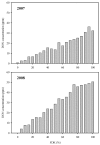Factors influencing deoxynivalenol accumulation in small grain cereals
- PMID: 23202310
- PMCID: PMC3509702
- DOI: 10.3390/toxins4111157
Factors influencing deoxynivalenol accumulation in small grain cereals
Abstract
Deoxynivalenol (DON) is a mycotoxin produced by the plant pathogenic fungi Fusarium graminearum and F. culmorum. These and other closely related fungi cause a disease known as Fusarium head blight (FHB) in small grain cereals. Other mycotoxins produced by FHB-causing fungi include nivalenol, T-2 toxin, and zearalenone. Ingestion of mycotoxin-contaminated food and feed can lead to toxicosis in humans and animals, respectively. DON is the predominant and most economically important of these mycotoxins in the majority of small grain-producing regions of the world. This review examines the factors that influence DON accumulation in small grain cereals from an agricultural perspective. The occurrence and economic importance of FHB and DON in small grain cereals, epidemiological factors and cereal production practices that favor FHB development and DON accumulation in grain under field conditions, and regulatory/advisory standards for DON in food and feed are discussed. This information can be used to develop strategies that reduce DON accumulation in grain before harvest and to mitigate the human and animal health risks associated with DON contamination of food and feed.
Figures






Similar articles
-
Fusarium Head Blight in Argentina, a Profile of Produced Mycotoxins and a Biocontrol Strategy in Barley During Micro-Malting Process.Toxins (Basel). 2025 Jan 15;17(1):39. doi: 10.3390/toxins17010039. Toxins (Basel). 2025. PMID: 39852992 Free PMC article.
-
Impact of epoxiconazole on Fusarium head blight control, grain yield and deoxynivalenol accumulation in wheat.Pestic Biochem Physiol. 2018 Nov;152:138-147. doi: 10.1016/j.pestbp.2018.09.012. Epub 2018 Sep 25. Pestic Biochem Physiol. 2018. PMID: 30497704
-
Impact of post-anthesis rainfall, fungicide and harvesting time on the concentration of deoxynivalenol and zearalenone in wheat.Food Addit Contam Part A Chem Anal Control Expo Risk Assess. 2015;32(12):2075-85. doi: 10.1080/19440049.2015.1084652. Epub 2015 Oct 14. Food Addit Contam Part A Chem Anal Control Expo Risk Assess. 2015. PMID: 26361223
-
Trichothecenes in Cereal Grains - An Update.Toxins (Basel). 2019 Oct 31;11(11):634. doi: 10.3390/toxins11110634. Toxins (Basel). 2019. PMID: 31683661 Free PMC article. Review.
-
Strategies for managing Fusarium head blight and deoxynivalenol accumulation in wheat.Int J Food Microbiol. 2007 Oct 20;119(1-2):126-30. doi: 10.1016/j.ijfoodmicro.2007.07.033. Epub 2007 Jul 31. Int J Food Microbiol. 2007. PMID: 17716767 Review.
Cited by
-
Natural Occurrence of Mycotoxin-Producing Fusaria in Market-Bought Peruvian Cereals: A Food Safety Threat for Andean Populations.Toxins (Basel). 2021 Feb 23;13(2):172. doi: 10.3390/toxins13020172. Toxins (Basel). 2021. PMID: 33672426 Free PMC article.
-
Key Global Actions for Mycotoxin Management in Wheat and Other Small Grains.Toxins (Basel). 2021 Oct 14;13(10):725. doi: 10.3390/toxins13100725. Toxins (Basel). 2021. PMID: 34679018 Free PMC article. Review.
-
Efficacy of Lamium album as a natural fungicide: impact on seed germination, ergosterol, and mycotoxins in Fusarium culmorum-infected wheat seedlings.Front Microbiol. 2024 Feb 23;15:1363204. doi: 10.3389/fmicb.2024.1363204. eCollection 2024. Front Microbiol. 2024. PMID: 38463484 Free PMC article.
-
Identification of an attenuated barley stripe mosaic virus for the virus-induced gene silencing of pathogenesis-related wheat genes.Plant Methods. 2016 Feb 2;12:12. doi: 10.1186/s13007-016-0112-z. eCollection 2016. Plant Methods. 2016. PMID: 26839581 Free PMC article.
-
Thermophilic Fungi to Dominate Aflatoxigenic/Mycotoxigenic Fungi on Food under Global Warming.Int J Environ Res Public Health. 2017 Feb 17;14(2):199. doi: 10.3390/ijerph14020199. Int J Environ Res Public Health. 2017. PMID: 28218685 Free PMC article.
References
-
- Desjardins A.E. Fusarium Mycotoxins. Chemistry, Genetics, and Biology. American Phytopathological Society; St. Paul, MN, USA: 2006.
-
- Miller J.D. Epidemiology of Fusarium ear diseases of cereals. In: Miller J.D., Trenholm H.L., editors. Mycotoxins in Grain. Compounds Other than Aflatoxin. Eagan Press; St. Paul, MN, USA: 1994. pp. 19–36.
-
- Dill-Macky R. Fusarium head blight (scab) In: Bockus W.W., Bowden R.L., Hunger R.M., Morrill W.L., Murray T.D., Smiley R.W., editors. Compendium of Wheat Diseases and Pests. 3rd. American Phytopathological Society; St. Paul, MN, USA: 2010. pp. 34–36.
-
- Liddell C.M. Systematics of Fusarium species and allies associated with Fusarium head bligh. In: Leonard K.J., Bushnell W.R., editors. Fusarium Head Blight of Wheat and Barley. American Phytopathological Society; St. Paul, MN, USA: 2003. pp. 35–43.
-
- Payne G.A. Ear and kernel rots. In: White D.G., editor. Compendium of Corn Diseases. 3rd. American Phytopathological Society; St. Paul, MN, USA: 1999. pp. 44–47.
Publication types
MeSH terms
Substances
LinkOut - more resources
Full Text Sources
Medical

